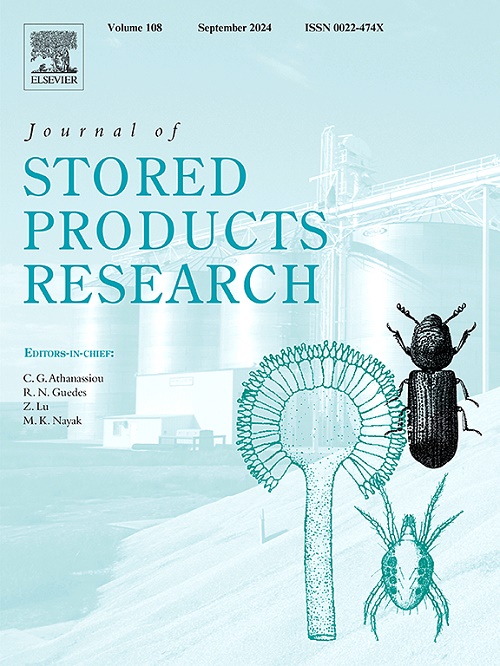Bioactive volatiles of Allium sativum and Brassica juncea for management of Tribolium castaneum and Corcyra cephalonica: Comprehensive in-silico and in-vitro analysis
IF 2.7
2区 农林科学
Q1 ENTOMOLOGY
引用次数: 0
Abstract
Stored grain insects, Tribolium castaneum (red flour beetle) and Corcyra cephalonica (rice moth) pose significant threats to global food security. In spite of effectiveness of the conventional fumigants, huge concerns raised for adverse effect on environmental and human health, thereby prompting interest in exploitation of plant-derived volatile oils (VOs) as eco-friendly alternatives. The present study aimed to evaluate fumigant toxicity of nine VOs of Myrtus communis (McEO), Citrus sinensis (CsEo), Melaleuca alternifolia (MaEO), Eucalyptus globulus (EgEO), Alllium sativum (GEO), and Brassica juncea (MEO) (four varieties individually) against T. castaneum and C. cephalonica. The fumigant toxicity of VOs varied in the order of GEO > MEO > CsEO > McEO > EgEO > MaEO. Fumigant action of GEO exhibited significant mortality against adults of T. castaneum (LC50 1.05 μL/L air, 24 h) followed by MEO (LC50 4.90–20.27 μL/L air, 24 h), CsEO (LC50 11.92 μL/L air, 24 h), and McEO (LC50 28.10 μL/L air, 24 h). In case of C. cephalonica larvae, MEO (LC50 9.52–21.55 μL/L air, 72 h) showed the highest response, followed by McEO (LC50 33.76 μL/L air, 72 h), CsEO (LC50 41.47 μL/L air, 72 h), and GEO (LC50 29.16 μL/L air, 72 h). Gas-Chromatography-Mass-Spectrometry (GC-MS) analysis of the most effective GEO revealed presence of diallyl disulfide (62.02 ± 2.48 %) and allyl monosulfide (36.84 ± 2.64 %), whereas MEO indicated abundance of 2-pentenenitrile (78.23 ± 2.69 % to 92.99 ± 2.10 %) in PM 28 (PM28-MEO), PM 30 (PM30-MEO), Pusa Karishma (PK-MEO), and Pusa Jagannath (PJ-MEO), along with trace amounts of allyl isothiocyanate (AITC), 1-butene-4-isothiocyanate, and 5-cyano-1-pentene. The McEO mainly consisted of α-pinene (48.21 ± 2.65 %) and 1,8-cineole (26.86 ± 2.33 %), whereas CsEO was predominantly made up of l-limonene (92.27 ± 3.08 %). In silico modelling depicted favourable binding affinity of AITC with arylalkylamine N-acyltransferase (AANAT, −16.06 kcal/mol) of T. castaneum supported by a hydrogen bond, π-sulfur, π-alkyl, and two alkyl-alkyl interactions. Whereas, 2-pentenenitrile interacted with juvenile hormone esterase (JHE, −15.87 kcal/mol) of C. cephalonica attributed to a π-alkyl, alkyl-alkyl, and two hydrogen bonds, thus explaining remarkable fumigant action of MEO. Further, allyl monosulfide interacted with JHE (−10.25 kcal/mol) of C. cephalonica via five alkyl-alkyl interactions and l-limonene with AANAT (−14.87 kcal/mol) of T. castaneum through two π-alkyl, and six alkyl-alkyl interactions, both resulting in target protein inhibition. These findings highlight the potential of GEO and MEO as natural fumigants for their inclusion in integrated pest management strategies, offering effective and environmentally sustainable solutions for protecting stored grains.

大蒜和芥菜的生物活性挥发物对蓖麻和菖蒲的管理:综合的硅内和体外分析
储粮昆虫、赤粉甲虫和米蛾对全球粮食安全构成重大威胁。尽管传统熏蒸剂的有效性,但对环境和人体健康的不利影响引起了人们的极大关注,从而促使人们对开发植物源性挥发油作为环保替代品的兴趣。研究了桃金树(Myrtus communis, McEO)、柑橘(Citrus sinensis, CsEo)、互花千层树(Melaleuca alternifolia, MaEO)、蓝桉(Eucalyptus globulus, EgEO)、葱黄(Alllium sativum, GEO)和芥菜(Brassica juncea, MEO) 4个品种9种挥发性有机化合物对castaneum和C. cephalonica的熏蒸毒性。挥发性有机化合物的熏蒸毒性按GEO和gt的顺序变化;MEO祝辞CsEO祝辞McEO的在EgEO祝辞MaEO。GEO熏蒸作用对木纹螟成虫的死亡率显著(LC50为1.05 μL/L, 24 h),其次是MEO (LC50为4.90 ~ 20.27 μL/L, 24 h)、CsEO (LC50为11.92 μL/L, 24 h)和McEO (LC50为28.10 μL/L, 24 h)。对头腹弧菌幼虫的反应以MEO (LC50 9.52 ~ 21.55 μL/L空气,72 h)最高,其次是McEO (LC50 33.76 μL/L空气,72 h)、CsEO (LC50 41.47 μL/L空气,72 h)和GEO (LC50 29.16 μL/L空气,72 h)。气相色谱-质谱(GC-MS)分析显示,最有效的GEO中存在二烯丙基二硫醚(62.02±2.48%)和烯丙基单硫醚(36.84±2.64%),而MEO显示PM28 (PM28-MEO), PM30 (PM30-MEO), Pusa Karishma (PK-MEO)和Pusa Jagannath (PJ-MEO)中的2-戊腈丰度(78.23±2.69%至92.99±2.10%),以及微量的异硫氰酸烯丙基(AITC), 1-丁烯-4-异硫氰酸酯和5-氰基-1-戊烯)。McEO主要由α-蒎烯(48.21±2.65%)和1,8-桉树脑(26.86±2.33%)组成,而CsEO主要由l-柠檬烯(92.27±3.08%)组成。在硅模型中,AITC与香基烷基胺n -酰基转移酶(AANAT,−16.06 kcal/mol)具有良好的结合亲和力,由一个氢键、π-硫、π-烷基和两个烷基-烷基相互作用支持。而2-戊烯腈则通过一个π-烷基、烷基-烷基和两个氢键与C. cephalonica的幼年激素酯酶(JHE,−15.87 kcal/mol)相互作用,从而解释了MEO具有显著的熏蒸作用。烯丙基单硫醚通过5个烷基-烷基相互作用与头孢霉的JHE相互作用(−10.25 kcal/mol), l-柠檬烯通过2个π-烷基和6个烷基-烷基相互作用与蜜桃的AANAT相互作用(−14.87 kcal/mol),均可抑制靶蛋白。这些发现突出了GEO和MEO作为天然熏蒸剂的潜力,可将其纳入害虫综合治理战略,为保护储粮提供有效和环境可持续的解决方案。
本文章由计算机程序翻译,如有差异,请以英文原文为准。
求助全文
约1分钟内获得全文
求助全文
来源期刊
CiteScore
5.70
自引率
18.50%
发文量
112
审稿时长
45 days
期刊介绍:
The Journal of Stored Products Research provides an international medium for the publication of both reviews and original results from laboratory and field studies on the preservation and safety of stored products, notably food stocks, covering storage-related problems from the producer through the supply chain to the consumer. Stored products are characterised by having relatively low moisture content and include raw and semi-processed foods, animal feedstuffs, and a range of other durable items, including materials such as clothing or museum artefacts.

 求助内容:
求助内容: 应助结果提醒方式:
应助结果提醒方式:


